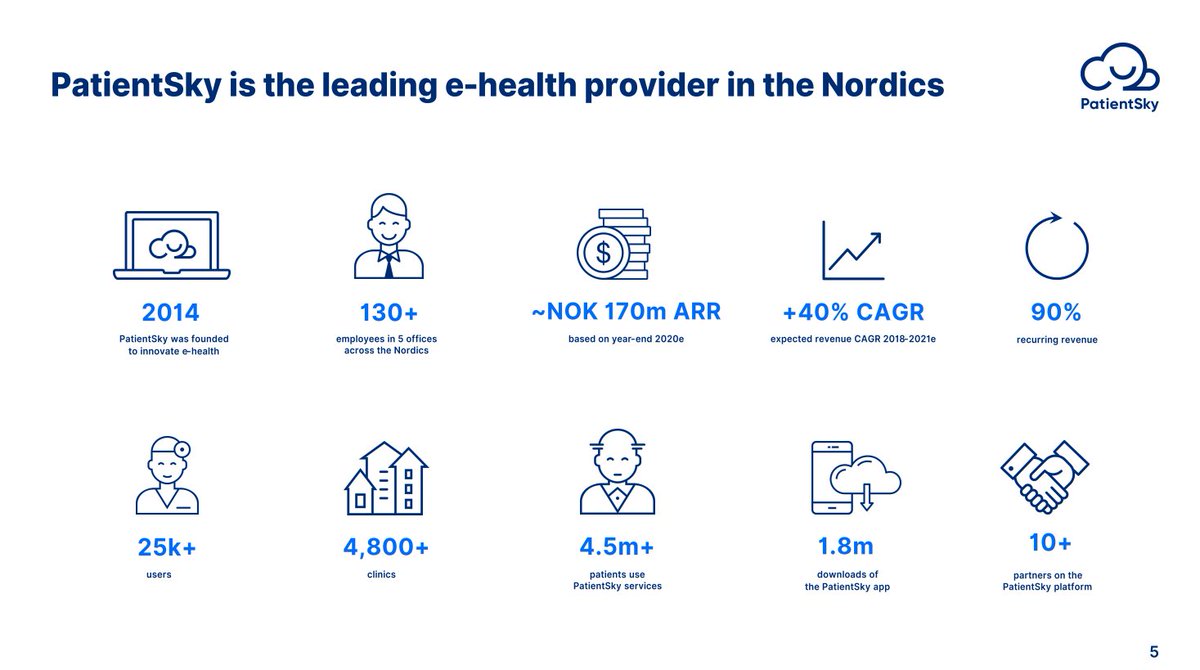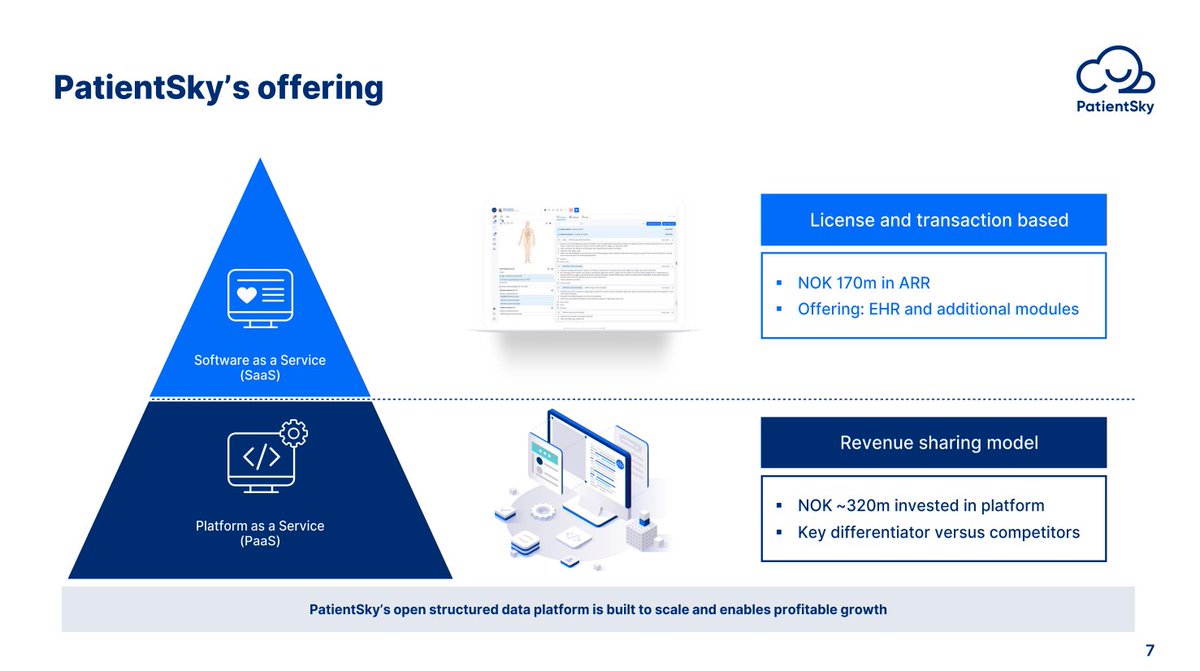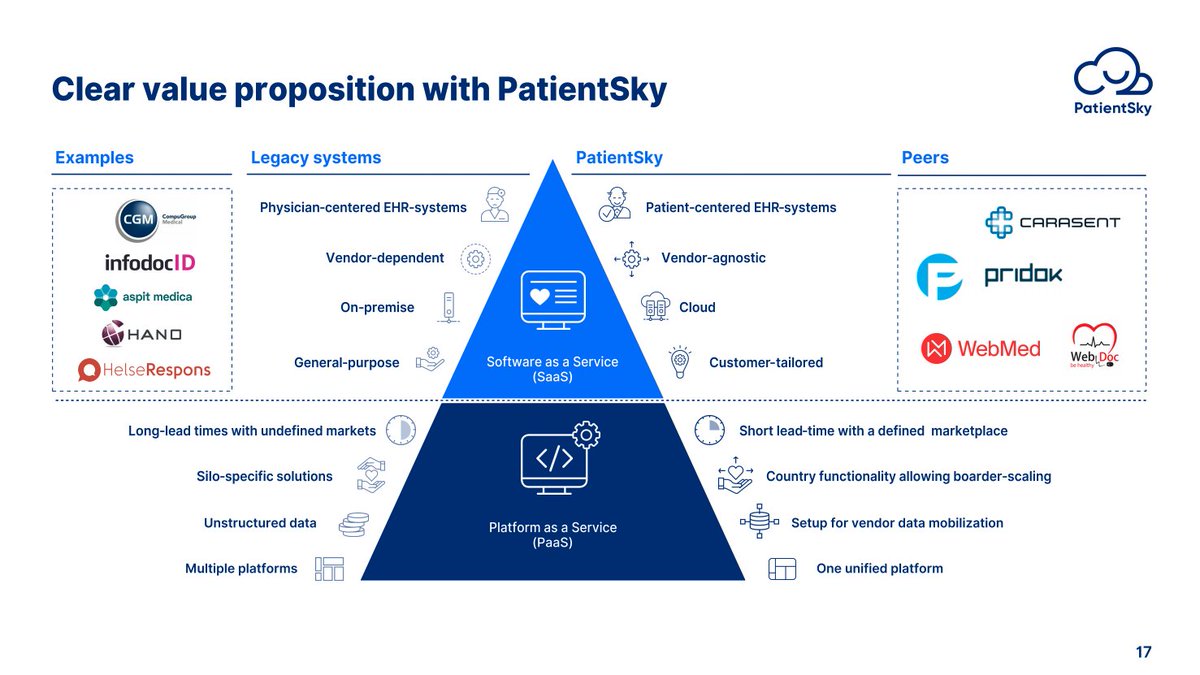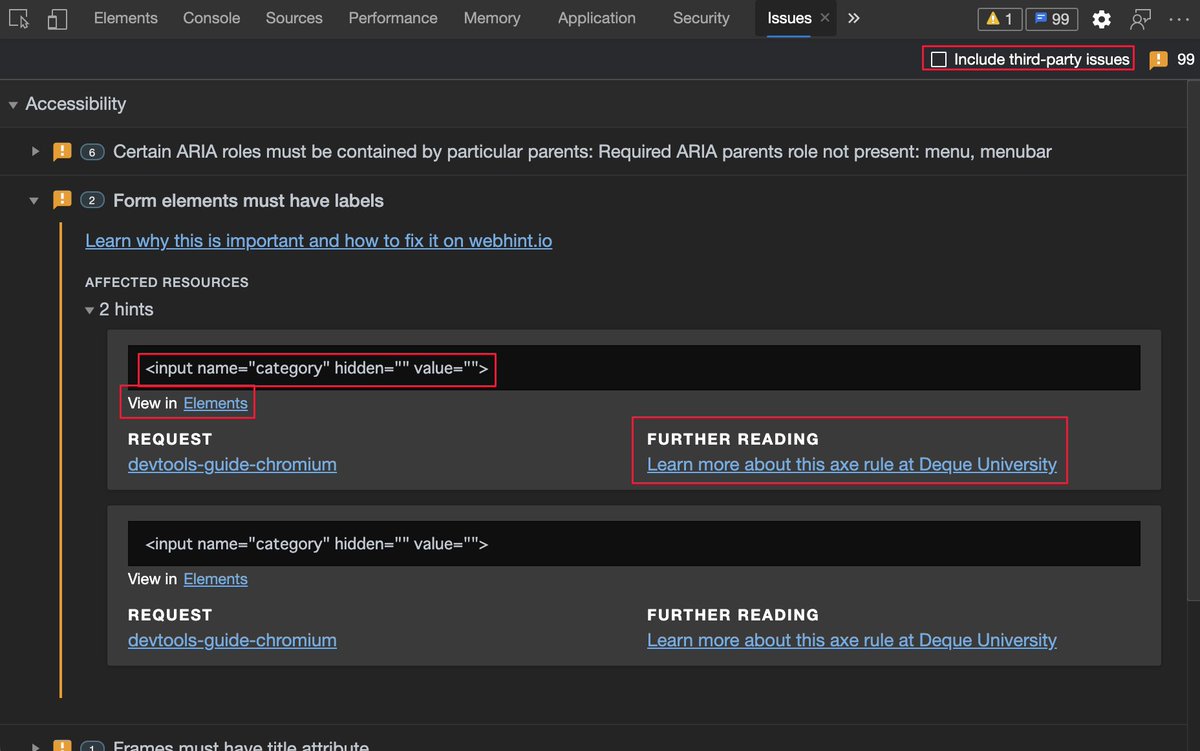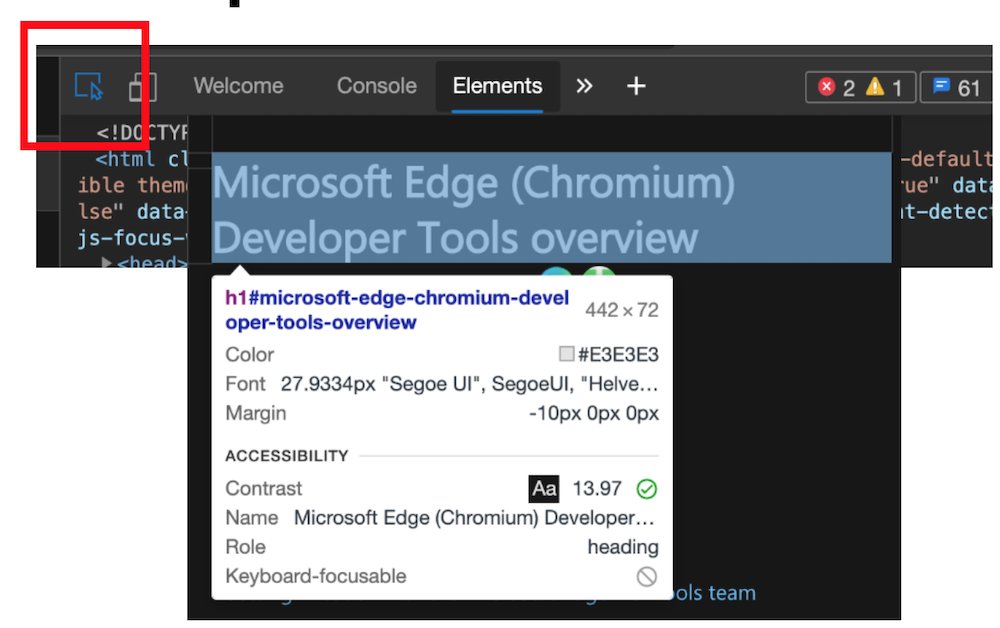PatientSky $PSKY.OL was founded in 2014 in Norway and started as a patient administration tool for clinics
🩺 It serves as a platform for ordering appointments, prescriptions, video consultations and e-consultations
The solution grew rapidly from 100.000 to 1.8m app downloads in less than 4 years
🥼 And it added a myriad of possibilities along the way, starting from a simple EHR management tool to a MedTech platform
1️⃣ By 2016 it counted 100k downloads and had morphed into a SaaS tool offering a task scheduler, internet connectivity and a VOIP module
2️⃣ By 2019, it counted over 1m app downloads and added an insurance module, Electronic Health Records (EHR) and a medication tool
✨ The company also introduced a Platform-as-a-Service tool, enabling its customers to build their own medical apps on top of PatientSky’s platform
3️⃣ By 2020, it expanded into hospitals and counted over 1.8m app downloads
🩺 The Product 🩺
PatientSky’s offering is made of a Patient management tool and a MetTech Platform
🚩 The EHR-landscape offers little differentiation possibilities and is regulated
✅ PatientSky therefor choose to build its advantage on top of its “platform offering”
1️⃣ Patient Management Tool
This is a conventional Electronic Health Records software, enabling clinics and hospitals to track their patient’s health
It also enables medical staff to arrange their patient’s bookings, book e-visits and sort out their patient’s medications
This tool works as a cloud Software-as-a-Service model and is:
· Used by over 25,000 practitioners and over 4,800 clinics
· Used most by General Practitioners, Physiotherapists and Psychologists
It enables practitioners to centralise all of their administrative tasks into one tool
💊 Reducing prescription errors by op to 70%
💸 Reduces yearly costs by NOK 78k per clinic on average
📲 Their mobile app reduces inbound calls with 54%
These solutions are replacing legacy systems which failed to integrate new technologies and operated on-premise
✅ PatientSky and other alternatives are cloud-based and can be customised to a greater extent to the physician’s needs
2️⃣ MedTech Platform
The market for patient management tools / healthcare CRM tools is crowded with (local) alternatives
⚖️ Each software has to comply with local rules in order to be eligible for state-reimbursements
PatientSky therefore decided to gradually transform their SaaS tool into a Platform-as-a-Service
📟 Providing a No-Code / Low-Code platform to other MedTech developers and clinics
🔥 Enabling these to build an app 100% customised to their own needs
🥇 This platform offers numerous features such as:
· Patient communications
· Security (patient verification, authority delegation, encryption)
· Internationalisation (translation, cross-border EHR)
· Mobile & apps
· Compliance (Secure file storage, audit tracking)
· Collaboration (Calendars, messages, patient records sharing)
· Hosting services and data-base management services
· Data migration
· Enterprise business intelligence integration
PatientSky’s platform is open to third-parties, these are the ones that build apps for PatientSky
✅ Effectively creating an ecosystem of healthcare-focussed apps for patient management
Similar to conventional applications stores, PatientSky will take a cut of the app’s revenue
🩺 The platform currently offers over 60 services
Great! But where are we now?
1️⃣ PatientSky’s SaaS-tool generates all of the NOK 170m in sales for 2020
2️⃣ It plans to monetise its app into 2021 in order to generate additional sales
3️⃣ The PaaS platform might start providing “additional upside” going into 2021
What about the market?
🌐 According to Grand View Research, the healthcare CRM market is set to reach $ 17.8B by 2025, a CAGR of 9.1% over the 2014 - 2025 period
📈 Driven by the rapidly ageing population, rise in chronic diseases, demand for operational efficiency in healthcare organisations and the rise of online consultations
https://t.co/k6ahm02zWV
🌐 According to Market Research Future, the healthcare CRM market is set to grow by 13.4% per year over the 2019 - 2025 period and was valued at $ 8.9B in 2018
📈 Driven by the increase in the number of hospitals & inclination towards automated workflows
https://t.co/HIIhqn0Laf
🌐 According to Mordor Intelligence, the market for practice management software is set to increase by 8.3% over the 2020 - 2025 period
📈 Driven by the need to increase practice-efficiency and increase the practitioner’s time spent with patients
https://t.co/lFzjlj8BQz
The market is fragmented, with local players providing the tools local practitioners need
🏛 But governments are constantly raising the bar for software to be eligible for subsidies
🏰 Raising the barrier to entries and chasing away smaller, local solutions
In order to expand its customer base and consolidate its position PatientSky acquired Infodoc
✅ Infodoc provides EHR, billing modules and appointment scheduling
💸 It paid $ 32m and Infodoc had sales of around $ 6.7m and is debt-free, for an EV / Sales of around 5
What do we have here?
✅ PatientSky generates $ 20m a year in sales through its cloud-based patient management tool
🔥 It plans to monetise its app, which has been downloaded 1.8m times by 2020 (vs 1m in 2019)
✨ It has invested $ 38m in its PaaS solution, which provides a Low / No Code platform for building fully-integrated healthcare CRM apps
“PatientSky is positioning itself to be the preferred platform for healthcare, upon which third party vendors can build applications that both work within the ecosystem in the platform and as stand-alone applications. […]”
Johan Zetterström, Group CEO of PatientSky
💸 Financial Check 💸
📈 Sales grew 26% form 2019 to 2020 and are expected to grew 38% from 2020 to 2021
💵 Operating expenses stood at 110% of sales for H1 ’20 vs 134% in 2019
💰 Current assets stood at NOK 510m ($ 60m) versus NOK 102 ($ 12m) in ST liabilities
💎 EBITDA margins stood at 15% in 2019 and are expected to reach 35% in 2020
👇 The Bottom Line 👇
✅ Market of patient management is growing by around 10% a year over 2020 - 2025 period as population is ageing
✅ Market is further driven by increasing efficiency and digitisation requirements, in part boosted by regulation
✅ PatientSky has developed its own patient management tool and grew sales to $ 20m / year
✅ It also counts 1.8m download for its app (which enables users to book appointments) and plans to monetise it
✅ PatientSky bets that one unified solution can be built and therefore invested $ 38m in its PaaS solution
✅ Using apps proposed by third-parties on the PatientSky platform, developers and practitioners can build their own fully-integrated and customised solution
🚩 Users report that the PatientSky app is encountering bugs and doesn’t work, compromising PatientSky’s ability to monetise it
🚩 Market for healthcare CRM tools is fragmented and depends heavily on local regulations
🚩 PatientSky hasn’t yet fully commercialised its PaaS offering and might first focus on correcting its app’s issues
🔥 We stay on the sidelines for now and wait for PatientSky to show commercial progress with its PaaS platform
🔮 $SF.ST is on our watchlist 👉 Coming SOON 🔮
Disclaimer - This is not investment advice in any form and investors are responsible for conducting their own research before investing.
Sources
✑ Investor presentation
✑ Company website
✑ Mordor Intelligence
✑ Grand View Research
✑ Market Research Future
Hope you liked this thread!
✅ For more content, follow us on Twitter 🔥
✅ EASY BRIEFINGS delivered straight to your inbox 📩 Don’t MISS IT 👇
https://t.co/lQ6ay1zmm2
